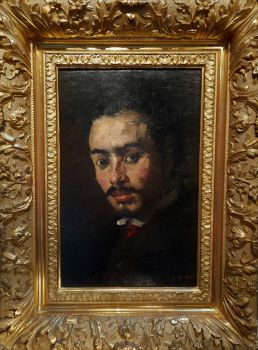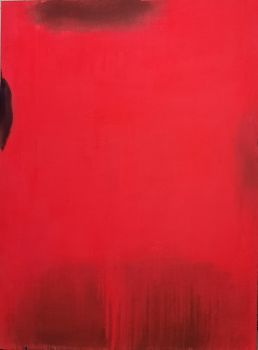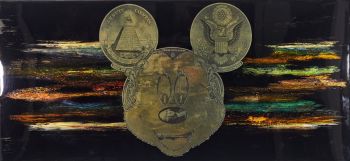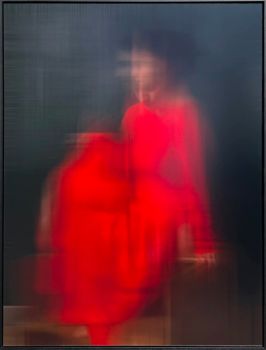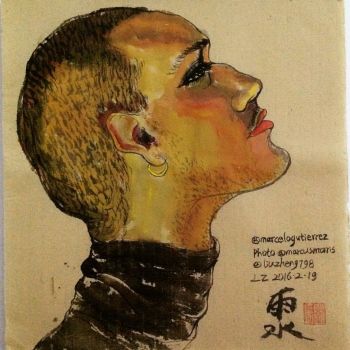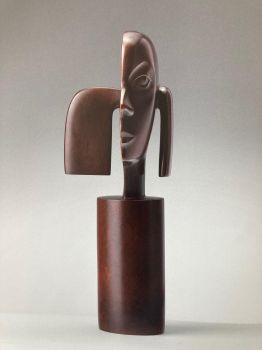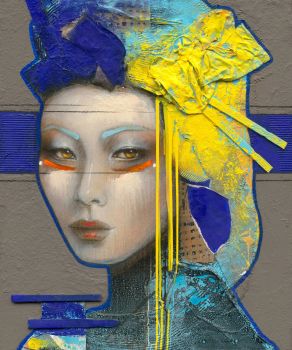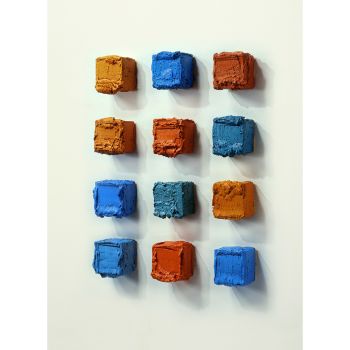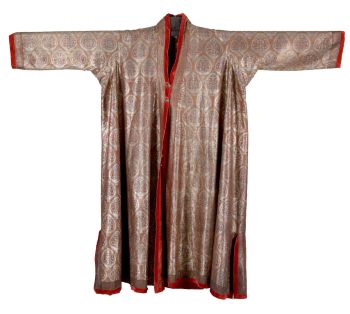Study of a Guarani man, Argentina, circa 1922 1922
José Moreno Carbonero
TelaPintura a óleoPintar
32 ⨯ 26 cm
Preço em pedido
Zebregs & Röell - Fine Art - Antiques
- Sobre arteJosé Moreno Carbonero (1858-1942)
Oil on canvas, H. 32.2 x W. 26 cm
Moreno Carbonero was born, brought up and studied in Malaga, Spain. In 1875, after a two-year stay in Morocco, he moved to Paris on a grant from the Malaga Provincial Council. He joined the studio of Jean-Léon Gérôme. A regular visitor, the famous art dealer Adolphe Goupil commissioned his first works, mainly small genre subject paintings. Between 1881 and 1884, Moreno Carbonero lived in Rome before moving to Madrid. There, he achieved his first success with his painting The Conversion of the Duke of Gandia, which is now in the Prado Museum. From then on, the artist specialized in history paintings, often on a large scale; the best example is The Entry of Roger de Flor into Constantinople, painted for the Madrid Senate in 1888, which hasn’t moved ever since. Besides being a historical painter, the artist was also a portraitist, painting elegant portraits of Madrid's high society (see, for instance, Purificacion Fontan, Marquise del Pazo de la Merced, 1908, Prado Museum, Madrid).
At the beginning of the 20th century, the Argentine government was preparing to celebrate the May Revolution, which started on May 18, 1810, and led to the independence of Argentina. The municipality of Buenos Aires, joining in the celebration, commissioned a historical painting dedicated to the founding of the capital from José Moreno Carbonero. Under time pressure, Moreno Carbonero produced a work with which he was dissatisfied and criticized when he arrived in Argentina in 1910. For this reason, in 1922, he asked for the work to be returned to him to correct it. He studied the city's history, the site and the event depicted in situ and made substantial changes to make the painting more historically accurate. The definitive work, wholly reworked, was placed in the municipal palace in 1924. It can still be admired in its original place.
The city of Buenos Aires was founded on June 11, 1580, by Juan de Garay under the name of the 'Santissima Trinidad y Puerto de Sant Maria del Buen Ayre'. In Moreno Carbonero's painting, Juan de Garay, in the centre of the composition, raises his sword before the foundation pillar. On the right, the notary Pedro de Xeres signs the foundation act; on the left, the friar Juan de Rivadeneira raises the cross, and the alderman Don Pedro de Quirós carries the royal standard. All around, men in arms can be seen, as well as representatives of the native people from the area, including a man from the Guarani ethnic group. The present painting is a preparatory sketch of the head of this figure. - Sobre artista
Nascido em Málaga, a 24 de março de 1858, José Moreno Carbonero formou-se inicialmente como artista na Escola Superior de Belas Artes da cidade, onde foi aluno de Bernardo Ferrándiz e desde muito cedo demonstrou um notável talento para a pintura. Depois de viajar para Sevilha e Paris com uma bolsa concedida pela Diputación de Málaga (conselho provincial), com apenas vinte e um anos executou ali a sua primeira grande pintura histórica, El príncipe de Viana (“O Príncipe de Viana”, 1881) , que o anunciou como um dos grandes mestres do género, como só alguns anos mais tarde o confirmaram obras tão significativas como La conversión del duque de Gandía (“A Conversão do Duque de Gandía”, 1884) e a esplêndida Entrada de Roger de Flor en Constantinopla (“Entrada de Roger de Flor em Constantinopla”, 1884), que foi encomendada pelo Senado e é indiscutivelmente uma das mais importantes pinturas da história espanhola do século XIX.
Em 1898 Moreno tornou-se membro da Academia de San Fernando de Madrid e estabeleceu-se definitivamente na cidade. A partir daí viveu confortavelmente no seu casarão da rua Miguel Ángel e foi aclamado como um dos mais reputados retratistas da alta sociedade, embora estas obras sejam os exemplos menos apelativos da sua obra. Ensinou Dalí e Picasso na Escola de Belas Artes e recebeu as mais altas condecorações e homenagens durante sua vida, como as cruzes de Alfonso XII e Isabel a Católica, entre outras. Ele também foi nomeado grande oficial da Coroa da Itália e de São Miguel da Baviera e comandante da Estrela Polar da Suécia.
Pintor extraordinariamente prolífico, além de pinturas históricas e retratos, também produziu cenas de gênero e orientalistas, pinturas de tipos humanos e vistas de cidades com edifícios monumentais. Destaca-se particularmente pelas suas inúmeras pinturas que ilustram episódios de obras literárias, especialmente Gil Blas e também Dom Quixote, pelas quais desenvolveu uma verdadeira paixão nas últimas décadas da sua vida. Ele morreu em Madrid em 15 de abril de 1942.
Você está interessado em comprar esta obra de arte?
Related artworks
Adrianus Johannes Groenewegen
Schaapsherder met kudde1874 - 1963
Preço em pedidoGalerie Het Noorderlicht
1 - 4 / 24- 1 - 4 / 24
- 1 - 4 / 24
Artista Desconhecido
Holandeses em miniatura (Netsuke)1700 - 1900
Preço em pedidoZebregs & Röell - Fine Art - Antiques
Artista Desconhecido
The Stamford Raffles Secretaires.1800 - 1813
Preço em pedidoZebregs & Röell - Fine Art - Antiques
Shiba Kokan
Pintura de um holandês fantásticoearly 19th
Preço em pedidoZebregs & Röell - Fine Art - Antiques
Engelbert Kaempfer
LIVRO ENGELBERT KAEMPFER1651 - 1716
Preço em pedidoZebregs & Röell - Fine Art - Antiques
1 - 4 / 12




